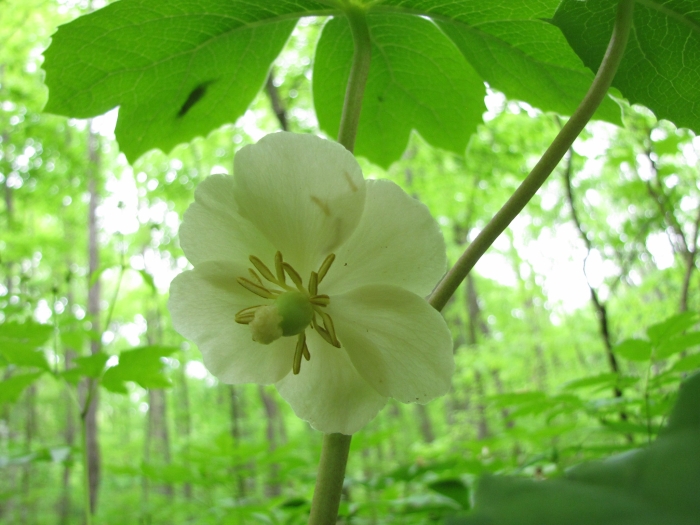Mayapple
(Podophyllum peltatum)
Mayapple (Podophyllum peltatum)
/
/

Buddha Dog
CC BY-SA 2.0






















































Estimated Native Range
Summary
The Mayapple is valued for its unique foliage and charming flowers, making it a popular choice for shade gardens and naturalized areas. Its fruit, once ripened to yellow, is safe to consume and has been used in traditional medicine. Gardeners appreciate Mayapple for its low maintenance and ability to spread as a ground cover in shady spots. It requires consistently moist soil and thrives in part to full shade, making it suitable for woodland gardens and areas under trees where other plants might struggle. While all parts of the plant are toxic when green, the ripe fruit is non-toxic. Mayapple is also recognized for its ecological role as a larval host for certain moth species, such as the golden borer moth and the may apple borer. However, care should be taken as it can be aggressive in garden settings, potentially outcompeting other understory plants.CC BY-SA 4.0
Plant Description
- Plant Type:
- Height: 1-1.5 feet
- Width: 0.8-1 feet
- Growth Rate: Moderate
- Flower Color: White
- Flowering Season: Spring
- Leaf Retention: Deciduous
Growth Requirements
- Sun: Part Shade, Full Shade
- Water: Medium
- Drainage: Medium, Slow
Common Uses
Bee Garden, Deer Resistant, Edible*Disclaimer: Easyscape's listed plant edibility is for informational use. Always verify the safety and proper identification of any plant before consumption.
Natural Habitat
Rich, moist deciduous forests in the understory layer
Other Names
Common Names: Indian-Apple , May Apple , Pomme De Mai , Wild-Mandrake , American Mandrake , Wild Mandrake , May-Apple , Ground Lemon , Entenfuß , Gewöhnlicher Maiapfel
Scientific Names: Podophyllum peltatum , Podophyllum peltatum f. deamii , Podophyllum peltatum f. biltmoreanum , Anapodophyllum peltatum , Podophyllum callicarpum , Podophyllum montanum , Podophyllum peltatum f. aphyllum , Podophyllum peltatum f. callicarpum , Podophyllum peltatum f. peltatum , Podophyllum peltatum var. annulare
GBIF Accepted Name: Podophyllum peltatum L.